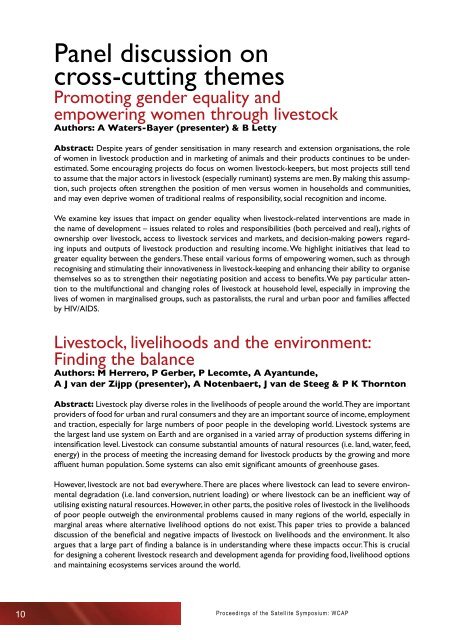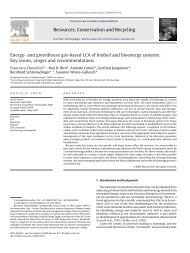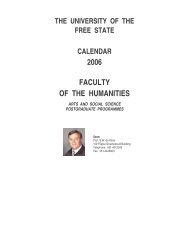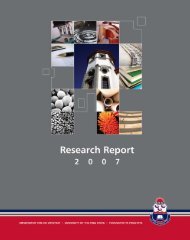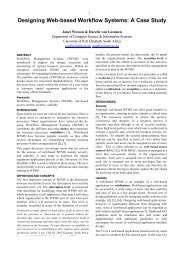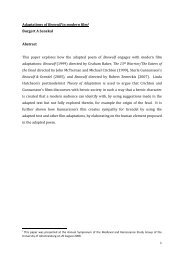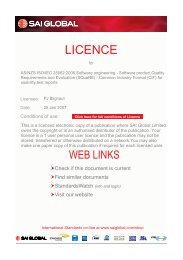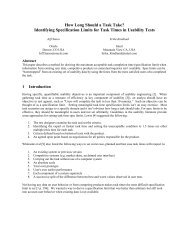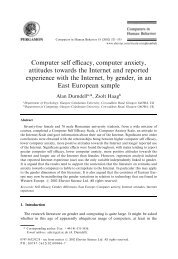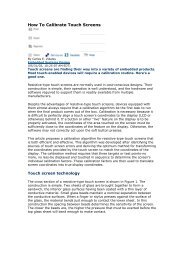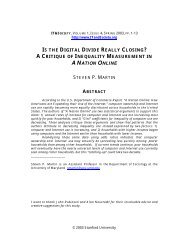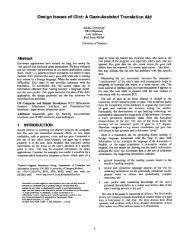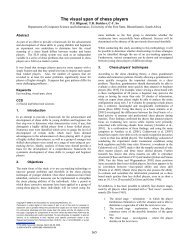the role of livestock in developing communities: enhancing ...
the role of livestock in developing communities: enhancing ...
the role of livestock in developing communities: enhancing ...
You also want an ePaper? Increase the reach of your titles
YUMPU automatically turns print PDFs into web optimized ePapers that Google loves.
Panel discussion on<br />
cross-cutt<strong>in</strong>g <strong>the</strong>mes<br />
Promot<strong>in</strong>g gender equality and<br />
empower<strong>in</strong>g women through <strong>livestock</strong><br />
Authors: A Waters-Bayer (presenter) & B Letty<br />
Abstract: Despite years <strong>of</strong> gender sensitisation <strong>in</strong> many research and extension organisations, <strong>the</strong> <strong>role</strong><br />
<strong>of</strong> women <strong>in</strong> <strong>livestock</strong> production and <strong>in</strong> market<strong>in</strong>g <strong>of</strong> animals and <strong>the</strong>ir products cont<strong>in</strong>ues to be underestimated.<br />
Some encourag<strong>in</strong>g projects do focus on women <strong>livestock</strong>-keepers, but most projects still tend<br />
to assume that <strong>the</strong> major actors <strong>in</strong> <strong>livestock</strong> (especially rum<strong>in</strong>ant) systems are men. By mak<strong>in</strong>g this assumption,<br />
such projects <strong>of</strong>ten streng<strong>the</strong>n <strong>the</strong> position <strong>of</strong> men versus women <strong>in</strong> households and <strong>communities</strong>,<br />
and may even deprive women <strong>of</strong> traditional realms <strong>of</strong> responsibility, social recognition and <strong>in</strong>come.<br />
We exam<strong>in</strong>e key issues that impact on gender equality when <strong>livestock</strong>-related <strong>in</strong>terventions are made <strong>in</strong><br />
<strong>the</strong> name <strong>of</strong> development – issues related to <strong>role</strong>s and responsibilities (both perceived and real), rights <strong>of</strong><br />
ownership over <strong>livestock</strong>, access to <strong>livestock</strong> services and markets, and decision-mak<strong>in</strong>g powers regard<strong>in</strong>g<br />
<strong>in</strong>puts and outputs <strong>of</strong> <strong>livestock</strong> production and result<strong>in</strong>g <strong>in</strong>come. We highlight <strong>in</strong>itiatives that lead to<br />
greater equality between <strong>the</strong> genders. These entail various forms <strong>of</strong> empower<strong>in</strong>g women, such as through<br />
recognis<strong>in</strong>g and stimulat<strong>in</strong>g <strong>the</strong>ir <strong>in</strong>novativeness <strong>in</strong> <strong>livestock</strong>-keep<strong>in</strong>g and enhanc<strong>in</strong>g <strong>the</strong>ir ability to organise<br />
<strong>the</strong>mselves so as to streng<strong>the</strong>n <strong>the</strong>ir negotiat<strong>in</strong>g position and access to benefits. We pay particular attention<br />
to <strong>the</strong> multifunctional and chang<strong>in</strong>g <strong>role</strong>s <strong>of</strong> <strong>livestock</strong> at household level, especially <strong>in</strong> improv<strong>in</strong>g <strong>the</strong><br />
lives <strong>of</strong> women <strong>in</strong> marg<strong>in</strong>alised groups, such as pastoralists, <strong>the</strong> rural and urban poor and families affected<br />
by HIV/AIDS.<br />
Livestock, livelihoods and <strong>the</strong> environment:<br />
F<strong>in</strong>d<strong>in</strong>g <strong>the</strong> balance<br />
Authors: M Herrero, P Gerber, P Lecomte, A Ayantunde,<br />
A J van der Zijpp (presenter), A Notenbaert, J van de Steeg & P K Thornton<br />
Abstract: Livestock play diverse <strong>role</strong>s <strong>in</strong> <strong>the</strong> livelihoods <strong>of</strong> people around <strong>the</strong> world. They are important<br />
providers <strong>of</strong> food for urban and rural consumers and <strong>the</strong>y are an important source <strong>of</strong> <strong>in</strong>come, employment<br />
and traction, especially for large numbers <strong>of</strong> poor people <strong>in</strong> <strong>the</strong> develop<strong>in</strong>g world. Livestock systems are<br />
<strong>the</strong> largest land use system on Earth and are organised <strong>in</strong> a varied array <strong>of</strong> production systems differ<strong>in</strong>g <strong>in</strong><br />
<strong>in</strong>tensification level. Livestock can consume substantial amounts <strong>of</strong> natural resources (i.e. land, water, feed,<br />
energy) <strong>in</strong> <strong>the</strong> process <strong>of</strong> meet<strong>in</strong>g <strong>the</strong> <strong>in</strong>creas<strong>in</strong>g demand for <strong>livestock</strong> products by <strong>the</strong> grow<strong>in</strong>g and more<br />
affluent human population. Some systems can also emit significant amounts <strong>of</strong> greenhouse gases.<br />
However, <strong>livestock</strong> are not bad everywhere. There are places where <strong>livestock</strong> can lead to severe environmental<br />
degradation (i.e. land conversion, nutrient load<strong>in</strong>g) or where <strong>livestock</strong> can be an <strong>in</strong>efficient way <strong>of</strong><br />
utilis<strong>in</strong>g exist<strong>in</strong>g natural resources. However, <strong>in</strong> o<strong>the</strong>r parts, <strong>the</strong> positive <strong>role</strong>s <strong>of</strong> <strong>livestock</strong> <strong>in</strong> <strong>the</strong> livelihoods<br />
<strong>of</strong> poor people outweigh <strong>the</strong> environmental problems caused <strong>in</strong> many regions <strong>of</strong> <strong>the</strong> world, especially <strong>in</strong><br />
marg<strong>in</strong>al areas where alternative livelihood options do not exist. This paper tries to provide a balanced<br />
discussion <strong>of</strong> <strong>the</strong> beneficial and negative impacts <strong>of</strong> <strong>livestock</strong> on livelihoods and <strong>the</strong> environment. It also<br />
argues that a large part <strong>of</strong> f<strong>in</strong>d<strong>in</strong>g a balance is <strong>in</strong> understand<strong>in</strong>g where <strong>the</strong>se impacts occur. This is crucial<br />
for design<strong>in</strong>g a coherent <strong>livestock</strong> research and development agenda for provid<strong>in</strong>g food, livelihood options<br />
and ma<strong>in</strong>ta<strong>in</strong><strong>in</strong>g ecosystems services around <strong>the</strong> world.<br />
10<br />
Proceed<strong>in</strong>gs <strong>of</strong> <strong>the</strong> Satellite Symposium: WCAP


